

The site of Granton Castle now lies within an overgrown and disjointed industrial area, and while none of the castle itself now remains, there is a section of boundary wall and a dovecot still standing.
Granton Castle was the principle residence in the barony of Wester Granton. The earliest mention of it (as “Grantoun House”) is in 1479, when it belonged to John Melville of Carnbee in Fife.
In 1544 the English under the Earl of Hertford landed close to Granton, and did considerable damage to Granton Castle. This would explain why Granton Castle has been described as a late 16th century castle, as it must have undergone serious reconstruction at this time.
Built on an L-plan, it stood on a rocky outcrop on a slope rising up from the River Forth, giving it a good defensive position with fine views along the Firth. Judging by photos of the ruined castle from the 1920s, the castle seems to have consisted of three storeys topped off with a garret. Within the re-entrant angle was a circular stair tower, with a doorway at ground level.
The castle was surrounded by a courtyard wall, with the castle itself forming the south-east corner. The wall followed the edge of the rock to the west, with a gateway into the courtyard in the north-west section of this west wall, approached by a sloping path. At the north end of the courtyard, just beyond the entrance, was a two storey building.
The courtyard enclosed to the north of the castle would have contained ancillary buildings, while an extension of the wall to the south enclosed a garden. Further gardens extended to the east of the castle, again enclosed by walls (which still survive).
The south wall of the castle featured four large rectangular windows on the first floor – possibly added in the 17th century – and small round turrets at the south-west and south-east corners of the second floor. A doorway with pediment above would have given access to the garden, and also looks like a 17th century addition.
The castle was sold to a John Russell in 1592, and in 1619 it was bought by Sir Thomas Hope of Craighall. Alterations were made, probably by Hope, in the 17th century, including the addition of a wing to the west, the south-west corner of which projected through the courtyard wall slightly.
In 1740 John Campbell, the 2nd Duke of Argyll, bought Granton Castle from the Hopes of Craighall, and renamed it Royston Castle. He had previously bought the neighbouring estate of Easter Granton, which included Royston Castle, in 1739, which he renamed Caroline Park.

With Argyll concentrating his efforts on Caroline Park, by 1749 Granton Castle was a ruin, and stayed that way throughout the 19th and early 20th centuries. In 1928 the castle was bought by a company called Bain & Brown, and it was destroyed so that the rock on which it stood could be quarried away.
However the walls of the castle’s eastern garden still survive, with the north side fronting onto the West Shore Road. It has been speculated the wall possibly dates back to the 16th century, but it may have been rebuilt in the 17th or 18th centuries.

A section of wall also runs approximately north to south from the south-west corner of this garden back up the hill to the castle’s doocot.

One section of the garden wall on the west side is topped off with corrugated metal fencing. This marks the point where the castle’s east wall once stood.

Alternative names for Granton Castle
Granton House; Grantoun House; Old Granton House; Royston Castle; Royston House; Roystoun Castle
Where is Granton Castle?
Granton Castle is in the parish of Edinburgh and the county of Midlothian.
Grid reference: NT 2258 7727
Lat / long: 55.982158, -3.242367










